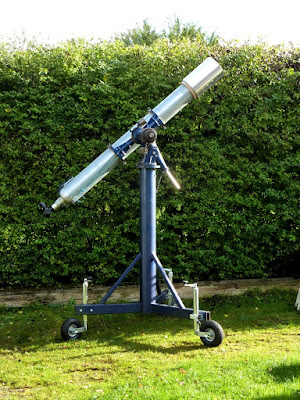*
 With the OTA nearing completion I had to check the balance around both axes. The OTA was now a little heavy for the earlier counterweights. Which were two 15lbs and one 10lbs for 40lbs total. I removed the spare weight clamp and fitted another 10lb counterweight inboard of the others. With the larger weights being placed deliberately nearer the end of the declination shaft to maximize their moment arm. Fortunately the 50lbs exactly balanced the 42lb, 19kg OTA. Otherwise I would have had to resort to using cast, barbel weights. Which are very handy but not as pretty on the eye as my turned steel weights. The MkIV is still coping well. With a very light action as I move the telescope about.
With the OTA nearing completion I had to check the balance around both axes. The OTA was now a little heavy for the earlier counterweights. Which were two 15lbs and one 10lbs for 40lbs total. I removed the spare weight clamp and fitted another 10lb counterweight inboard of the others. With the larger weights being placed deliberately nearer the end of the declination shaft to maximize their moment arm. Fortunately the 50lbs exactly balanced the 42lb, 19kg OTA. Otherwise I would have had to resort to using cast, barbel weights. Which are very handy but not as pretty on the eye as my turned steel weights. The MkIV is still coping well. With a very light action as I move the telescope about. The OTA itself now balances with 18" from the top tube ring to the dewshield base. And 27" from the bottom ring to the back plate where the focuser fits. The OTA is now 8', or 96" long from the tip of the dewshield to the back of the star diagonal and reaches 11' or 3.3m from the ground when pointing at the Pole Star.
The OTA itself now balances with 18" from the top tube ring to the dewshield base. And 27" from the bottom ring to the back plate where the focuser fits. The OTA is now 8', or 96" long from the tip of the dewshield to the back of the star diagonal and reaches 11' or 3.3m from the ground when pointing at the Pole Star.The sliding [OTA] balance weight is now near the minimum value of its full range. Allowing a large extra margin for eyepieces and cameras to be fitted to the focuser. Without causing any OTA imbalance nor demanding the sliding weight increase its weight or range beyond the present set-up.
 Another image showing the OTA pointing south in rare, autumn sunshine.
The weather has been continuously overcast with rain and mist at regular
intervals for what seems like weeks. Amateur astronomers often joke
about new telescopes acting as cloud magnets. With luck my, cheap as
possible, DIY efforts will NOT attract a full complement of bad weather!
Another image showing the OTA pointing south in rare, autumn sunshine.
The weather has been continuously overcast with rain and mist at regular
intervals for what seems like weeks. Amateur astronomers often joke
about new telescopes acting as cloud magnets. With luck my, cheap as
possible, DIY efforts will NOT attract a full complement of bad weather!I am keen to try the telescope on the Moon or planets. The last time I tried it out, the OTA slid right down through the rings in the dark. I had lined the over-sized tube rings with thick, firm foam. Which had proved to be too slippery even when compressed. Fortunately I had fitted security cords for just such an eventuality. Though making any useful observations was almost impossible. As I had to support the OTA and maintain its balance while looking though it. It was lucky there were no useful targets at that time. The weather has never remotely cooperated since then. So there was never any great pressure to finish the telescope. I think I am finally there now except for painting the entire thing. While Hammerite might have been the first choice only a few years back it is claimed that it no longer has its original protective qualities. The removal of toxic contents has left it with a much poorer performance according to some online forums.
With an overall height of 8' while resting on its dewshield I can no longer reach the focuser to cap it for storage. There is now no room for the star diagonal under the ceiling. So I had to resort to a crate for extra reach just to fit a plug in place of an eyepiece. I am increasingly recognizing why classical refractors were permanently housed in observatories. Even at a modest f/12 a 7" is a very long, or tall object to handle, carry, mount and store. I am just grateful I didn't choose an 8" f/15 achromat! Even a traditional 6" f/15 would have been longer than my 7" by at least 6". Thanks to the R35 optical correction I get a 7" f/15 achromat equivalent in [much more manageable] f/12 dimensions.
Click on any image for an enlargement.
*
No comments:
Post a Comment